Research on Arc Extinguishing Characteristics of Single-Phase Grounding Fault in Distribution Network
Abstract
1. Introduction
2. Establishment of Three-Dimensional Single-Phase Grounding Arc Mathematical Model
2.1. Arc Model Description
2.2. Arc Magnetohydrodynamic Model
- The arc is in a state of local thermodynamic equilibrium.
- The plasma flow is laminar. In fluid mechanics, the Reynolds number serves as a criterion to characterize fluid flow, with its expression being the following:
- 3.
- Ignore the arc initiation process.
- (a)
- Continuity equation
- (b)
- Momentum conservation equation
- (c)
- Energy conservation equation
- (d)
- Current continuity equation
2.3. Arc Geometry Model and Boundary Setting
2.4. Three Dimensional Arc Simulation Calculation
3. Experimental Work
3.1. Establishment of Experimental Circuit
3.2. Experimental Results
3.3. Comparative Analysis of Simulation and Experiment
4. The Influence of Different Boundary Conditions on Arc Extinguishing
4.1. The Influence of Gap on Arc Extinguishing Under Windless Conditions
4.2. The Influence of Wind Speed on Arc Extinguishing Under a Fixed Gap
5. Conclusions
Author Contributions
Funding
Data Availability Statement
Acknowledgments
Conflicts of Interest
References
- Xu, L.; Li, Y.; Yuan, W.; Li, T.; Chen, X. An Adaptive Faulty Phase Detection Method Based on Wavelet Packet Reconstruction Energy of Three-phase Voltage Signals in Resonant Grounded Distribution Systems. Electr. Power Syst. Res. 2023, 225, 109774. [Google Scholar] [CrossRef]
- Qin, J.; Ning, X.; Fan, S.; Jia, Z. Discharge Ignition Mechanism of Tree-contacting Single-phase-to-ground Faults of Overhead Lines. Power Syst. Technol. 2023, 47, 1289–1298. [Google Scholar]
- Yuan, W.; Li, Y.; Xu, L.; Li, T.; Chen, X. A Fast Faulty Phase Selection Method Considering Fault Tolerance for Single phase to Ground Fault in Distribution Networks. IEEE Trans. Instrum. Meas. 2023, 72, 1–12. [Google Scholar] [CrossRef]
- Zhang, F.; Xue, Y.; Li, G.; Xu, B. A Method for Measuring and Adjusting the Detuning of Resonant Grounding Systems with Transient Information after Arc Extinction. IEEE Trans. Power Deliv. 2023, 38, 496–504. [Google Scholar] [CrossRef]
- Kachesov, V.; Lebedev, A.; Kitova, E. Monitoring in 6–35 kV Power Networks, Location of Single-phase Ground Fault and Detection of Fault Feeder. Int. J. Electr. Power Energy Syst. 2023, 152, 109271. [Google Scholar] [CrossRef]
- Shaalan, E.M.; Ghania, S.M.; Ward, S.A. Analysis of Electric Field inside HV Substations using Charge Simulation Method in Three Dimensional. In Proceedings of the 2010 Annual Report Conference on Electrical Insulation and Dielectic Phenomena CEIDP, 17–20 October 2010; p. 5724041. [Google Scholar]
- Ahmed, K.M.; Allam, T.M.; El-sayed, H.A.; Soliman, H.M.; Ward, S.A.; Saied, E.M. Design, Construction and Characterization of AC Atmospheric Pressure Air Non-thermal Plasma Jet. J. Fusion Energy 2014, 33, 627–633. [Google Scholar] [CrossRef]
- Mansour, D.-E.A.; Shaalan, E.A.; Ward, S.A.; Dein, A.Z.E.; Karaman, H.S. Multiple Nanoparticles for Enhancing Breakdown Strength and Heat Transfer Coefficient of Oil Nanofluids. In Proceedings of the 2017 Nineteenth International Middle East Power Systems Conference (MEPCON), Cairo, Egypt, 19–21 December 2017. [Google Scholar]
- Hong, C.; Qiu, H.-Y.; Gao, J.-H.; Lin, S.; Guo, M.-F. Semantic Segmentation-Based Intelligent Threshold-Free Feeder Detection Method for Single-phase Ground Fault in Distribution Networks. IEEE Trans. Instrum. Meas. 2024, 73, 1–9. [Google Scholar] [CrossRef]
- Liang, H.; Li, H.; Wang, G. A Single-Phase-to-Ground Fault Detection Method Based on the Ratio Fluctuation Coefficient of the Zero-sequence Current and Voltage Differential in a Distribution Network. IEEE Access 2023, 11, 7297–7308. [Google Scholar] [CrossRef]
- Zhang, Z.; Liu, J.; Shao, W.; Wang, Y. Fault Line Selection Using Multiple Disturbance Characteristics of Fault phase Active Grounding in Resonant Grounded Distribution Networks. Int. J. Electr. Power Energy Syst. 2022, 138, 107931. [Google Scholar] [CrossRef]
- Wang, Y.; Liu, J.; Zhang, Z.; Zheng, T.; Ren, S.; Chen, J. A Faulty Line Detection Method for Single Phase-to-ground Fault in Resonant Grounding System with CTs Reversely Connected. Int. J. Electr. Power Energy Syst. 2023, 147, 108873. [Google Scholar] [CrossRef]
- Chen, H.; Lin, X.; Li, G.; Xu, J.; Li, H.; Wang, S. Experimental Research and Numerical Simulation of Single Soil-arc-grounding-fault in Distribution Networks. Wirel. Commun. Mob. Comput. 2021, 2021, 1875068. [Google Scholar] [CrossRef]
- Achitaev, A.A.; Suslov, K.V.; Volkova, I.O.; Kozhemyakin, V.E.; Dvoryansky, Y.V. Development of an Algorithm for Identifying Single-phase Ground Fault Conditions in Cable and Overhead Lines in The Networks with Isolated Neutral. Energy Rep. 2023, 9, 1079–1086. [Google Scholar] [CrossRef]
- Wan, G.; Xu, X. Research on Single-phase Grounding Detection Method in Small-current Grounding Systems Based on Image Recognition. Front. Energy Res. 2024, 12, 1473472. [Google Scholar] [CrossRef]
- Tang, T.; Huang, C.; Li, Z.; Yuan, X. Identifying Faulty Feeder for Single-phase High Impedance Fault in Resonant Grounding Distribution System. Energies 2019, 12, 598. [Google Scholar] [CrossRef]
- Mayr, O. Beiträge zur Theorie des statischen und des dynamischen Lichtbogens. Arch. Für Elektrotechnik 1943, 37, 588–608. [Google Scholar] [CrossRef]
- Cassie, A.M. Arc Rupture and Circuit Severity: A New Theory; CIGRE Report; Internationale des Grands Reseaux Electriques’a Haute Tension (CIGRE): Paris, France, 1939. [Google Scholar]
- Schavemaker, P.H.; van der Sluis, L. An improved Mayr-type Arc Model Based on Current-zero Measurements. IEEE Trans. Power Deliv. 2000, 15, 580–584. [Google Scholar] [CrossRef]
- Khakpour, A.; Franke, S.; Gortschakow, S.; Uhrlandt, D.; Methling, R.; Weltmann, K.-D. An Improved Arc Model Based on the Arc Diameter. IEEE Trans. Power Deliv. 2016, 31, 1335–1341. [Google Scholar] [CrossRef]
- Gouda, O.E.; Ibrahim, D.K.; Soliman, A. Parameters Affecting the Arcing Time of HVDC Circuit Breakers Using Black Box Arc Model. IET Gener. Transm. Distrib. 2019, 13, 461–467. [Google Scholar] [CrossRef]
- Ferraz, R.G.; Iurinic, L.U.; Filomena, A.D.; Gazzana, D.S.; Bretas, A.S. Arc Fault Location: A Nonlinear Time Varying Fault Model and Frequency Domain Parameter Estimation Approach. Int. J. Electr. Power Energy Syst. 2016, 80, 347–355. [Google Scholar] [CrossRef]
- Wang, B.; Cui, X. Nonlinear Modeling and Analytical Analysis of Arc High Resistance Grounding Fault in Distribution Network with Neutral Grounding via Arc Suppression Coil. Proc. CSEE 2021, 41, 3864–3872. [Google Scholar]
- Wang, B.; Geng, J.; Dong, X. High-impedance Fault Modeling Based on Solid Dielectric Electrical Breakdown Theory. Autom. Electr. Power Syst. 2014, 38, 62–66. [Google Scholar]
- Nam, S.R.; Park, J.K.; Kang, Y.C.; Kim, T.H. A Modeling Method of a High Impedance Fault in a Distribution System Using Two Series Time-varying Resistances in EMTP. Proc. IEEE Power Eng. Soc. Trans. Distrib. Conf. 2001, 2, 1175–1180. [Google Scholar]
- Jiang, C.; Bi, M.; Zhang, S.; Li, K.; Lei, S.; Jiang, T. Study on Arc Characteristics and Combustion Feature of Tree-wire Discharge Fault in Distribution Line. Electr. Power Syst. Res. 2024, 230, 110210. [Google Scholar] [CrossRef]
- Li, G.; Huang, K.; He, J.; Sun, S.; Liu, Q. Simulation Study on Arc Characteristics of Single Phase Grounding Overhead Line Tree in Distribution Network. In Proceedings of the 2023 5th International Academic Exchange Conference on Science and Technology Innovation (IAECST), Guangzhou, China, 8–10 December 2023; pp. 1302–1306. [Google Scholar]
- Yan, X.; Chen, W.; He, Z.; Wang, C.; Wu, J.; Wang, J. Temperature Measurement of Air Arc in Long Gap by Spectrum Diagnosis. Proc. CSEE 2011, 31, 146–152. [Google Scholar]
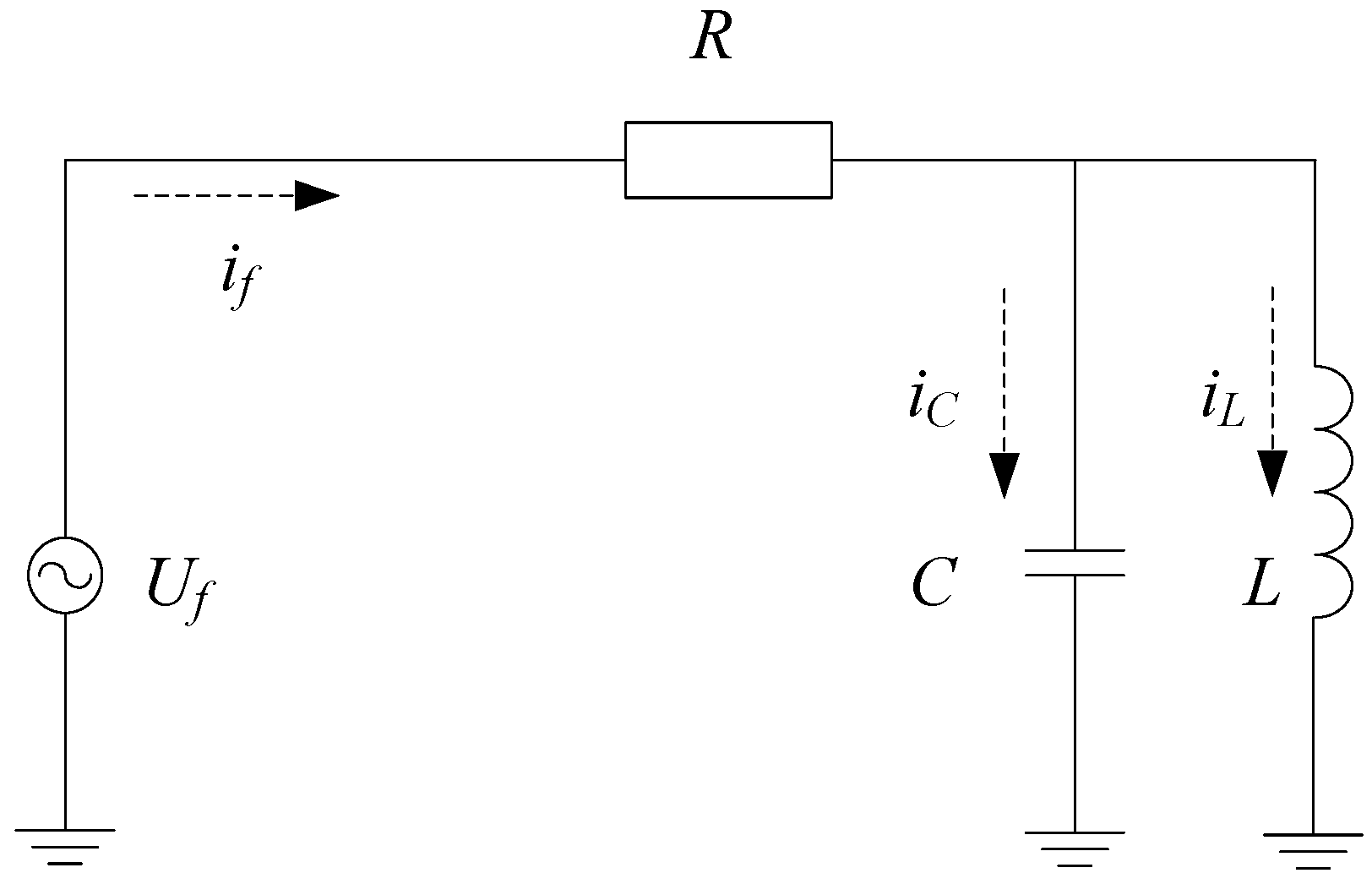




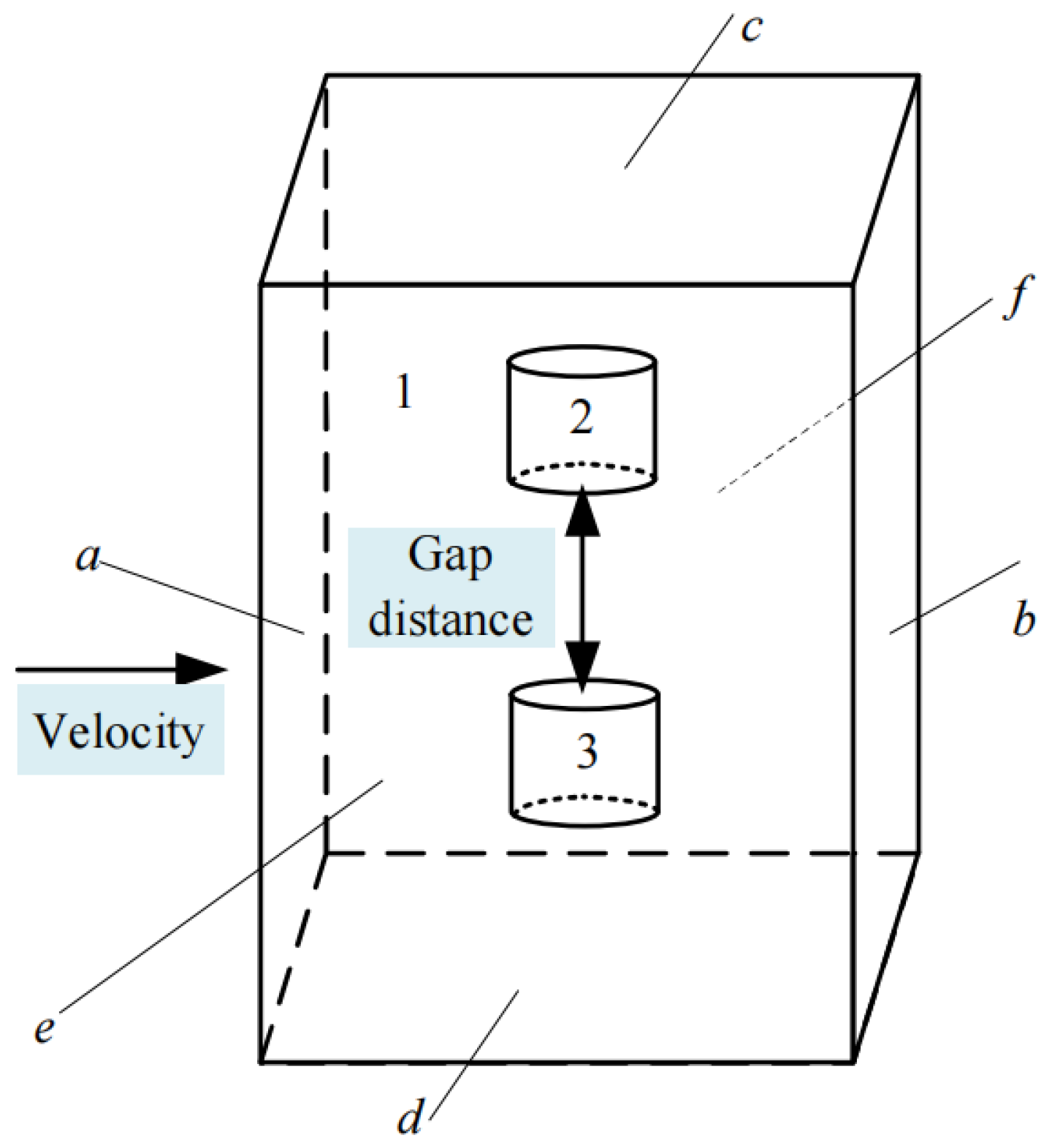
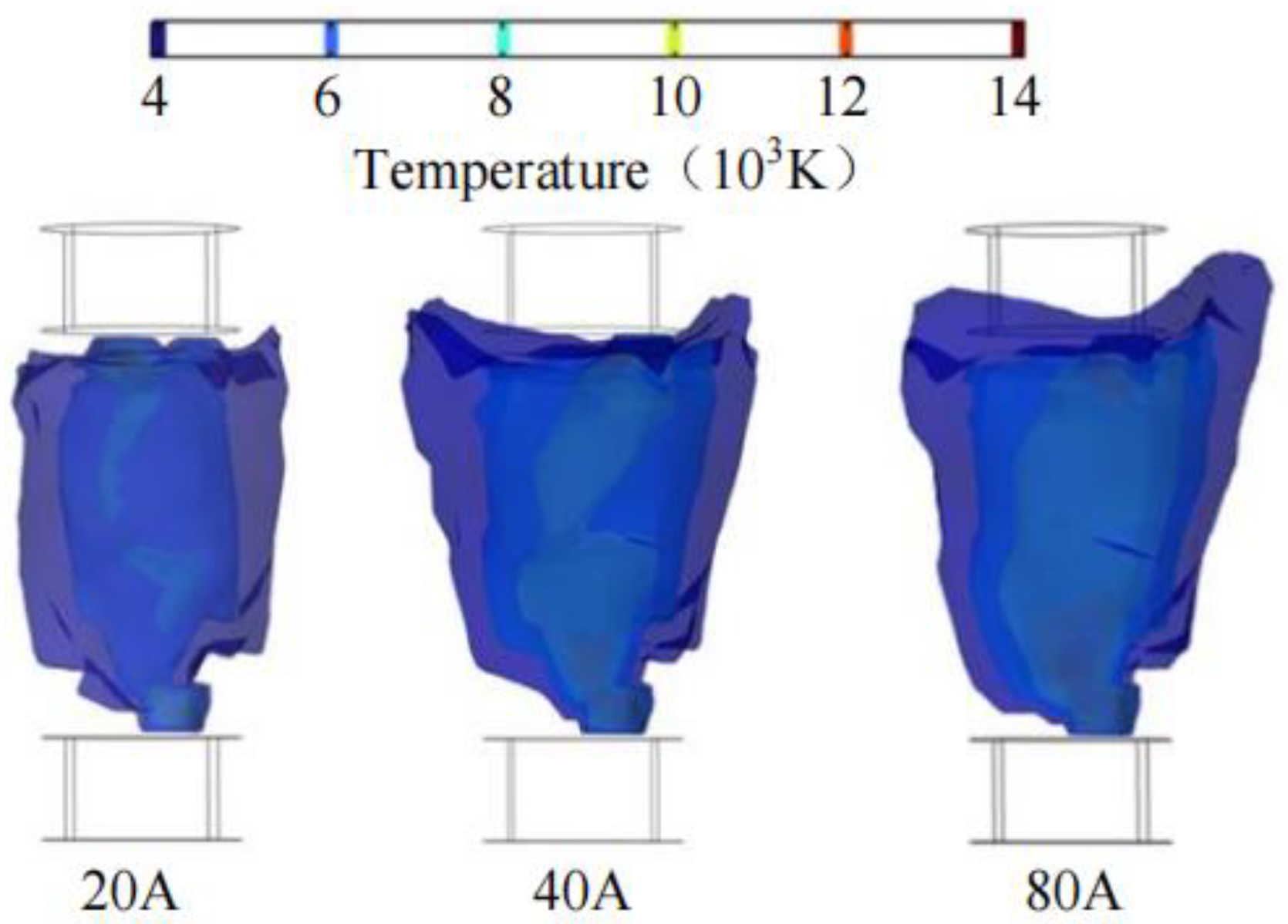


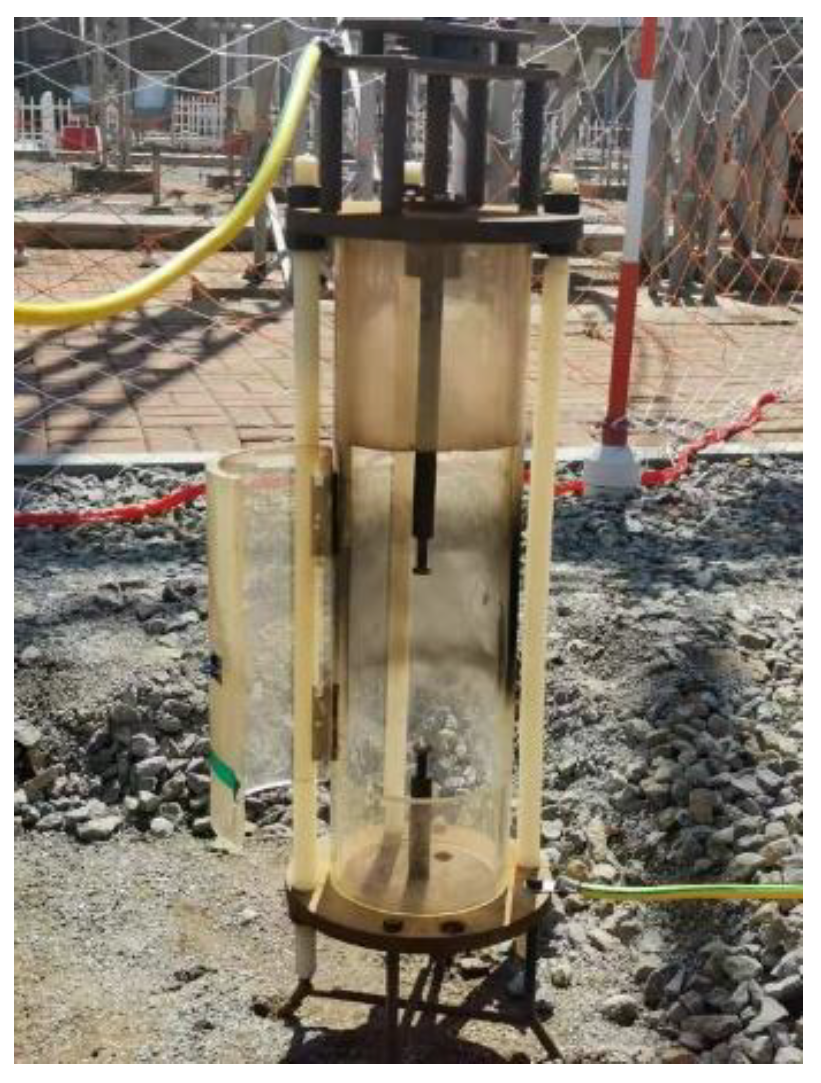
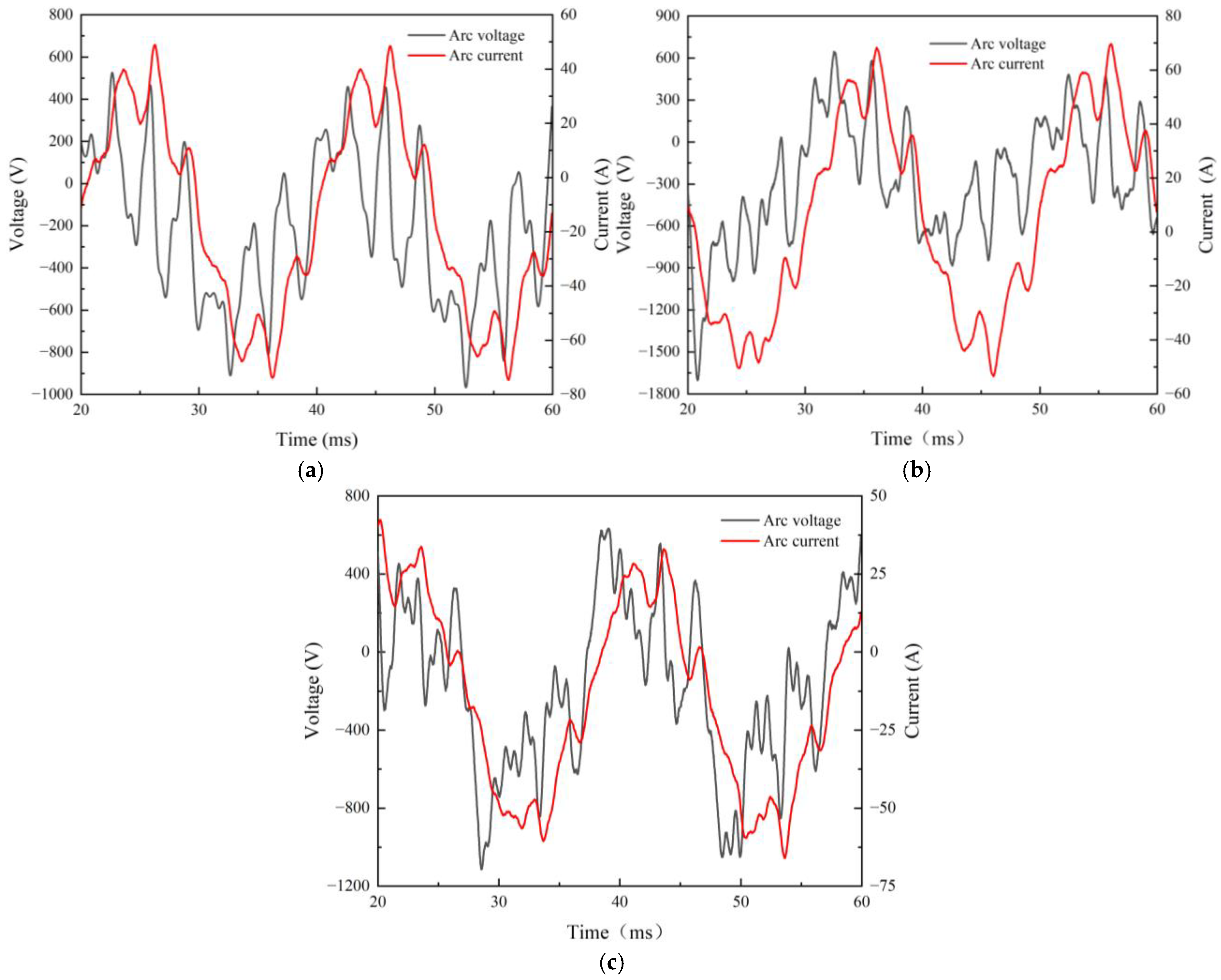
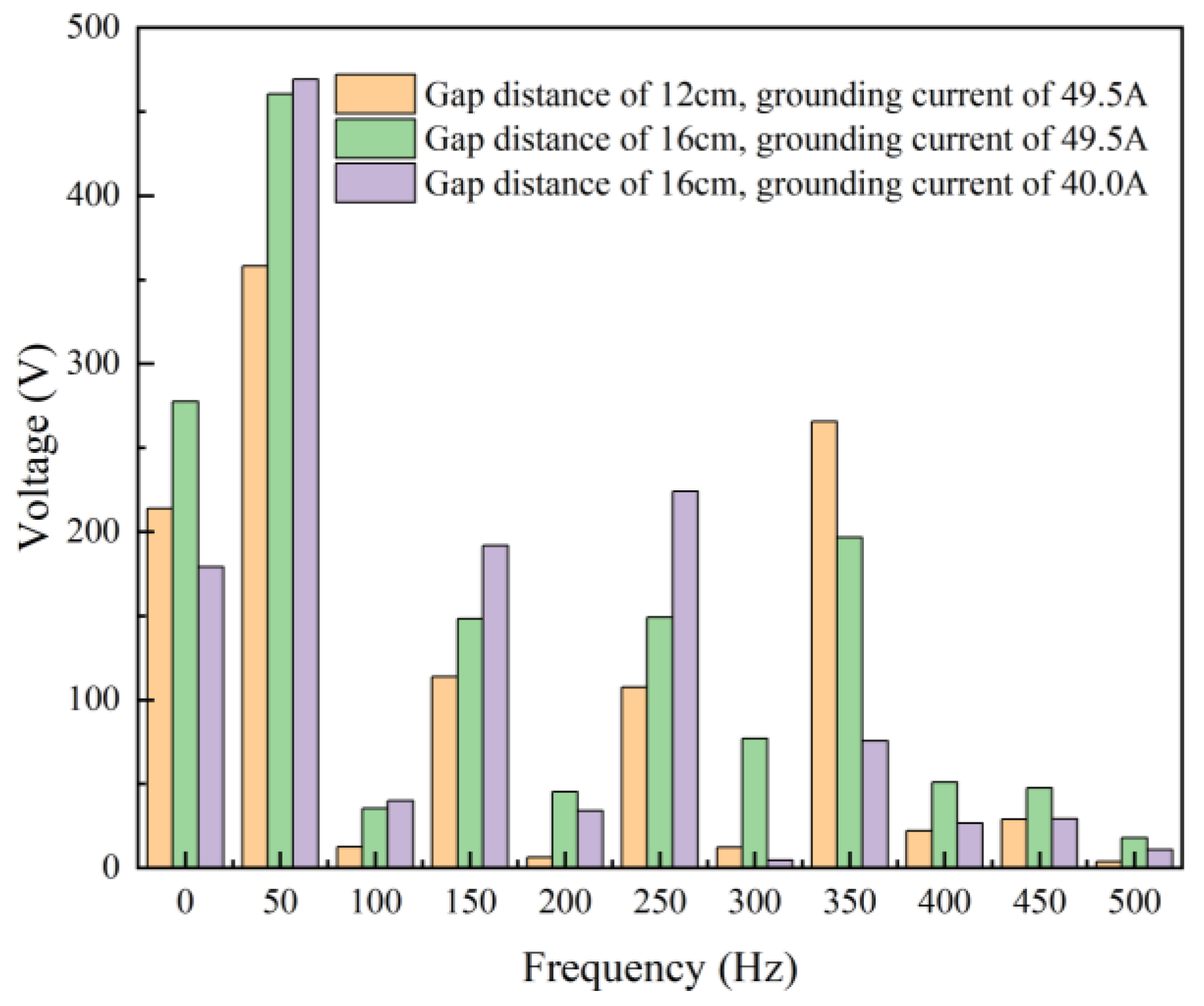
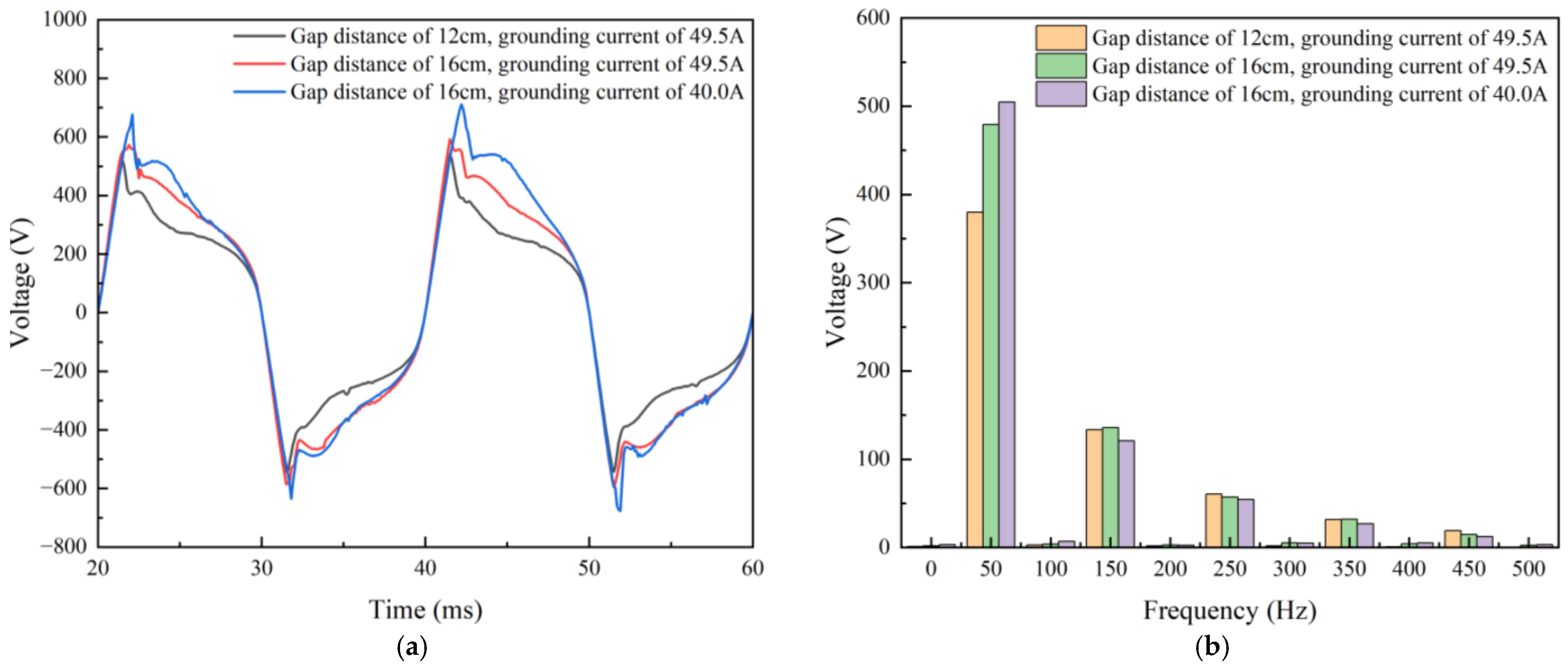
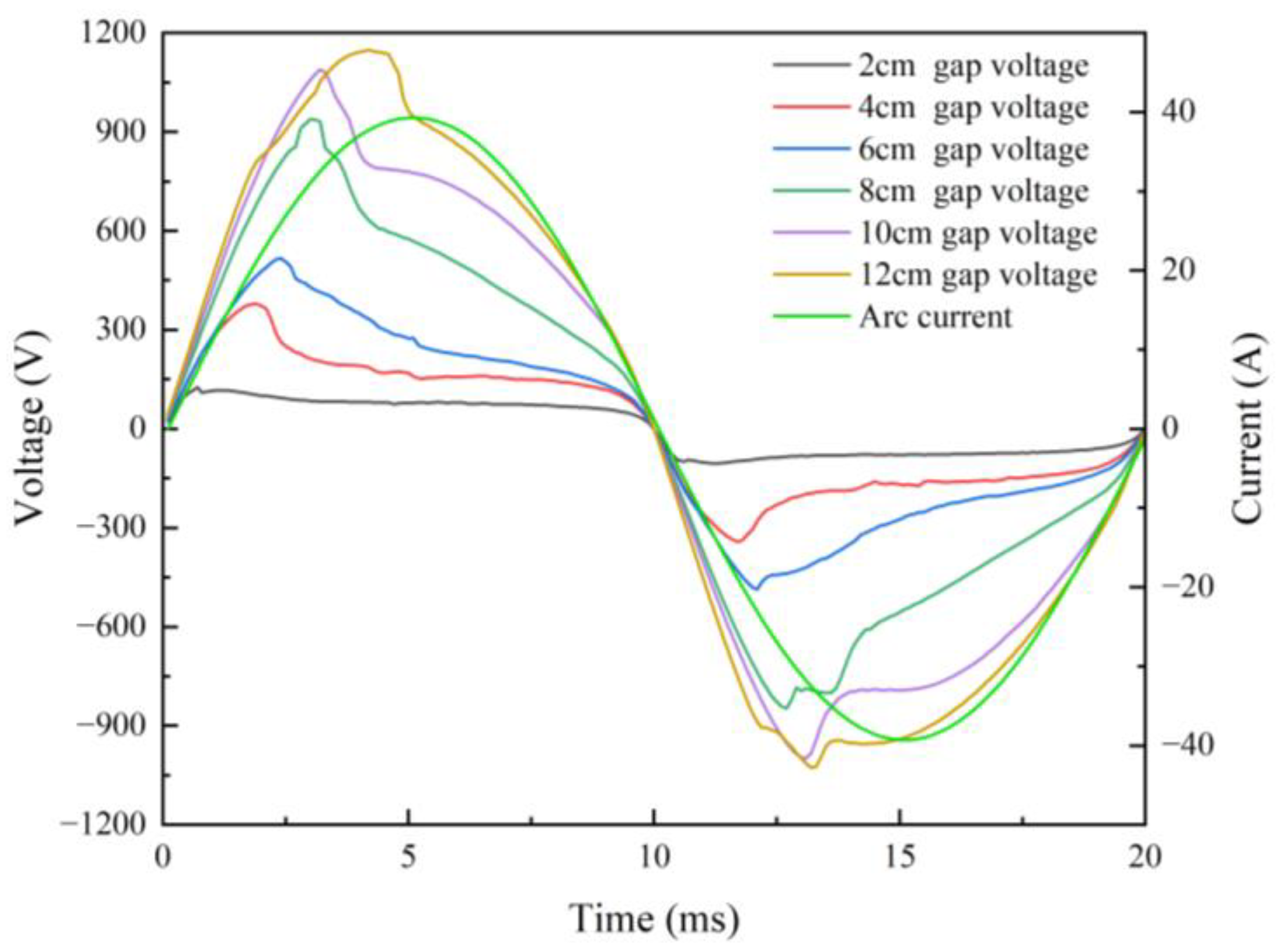


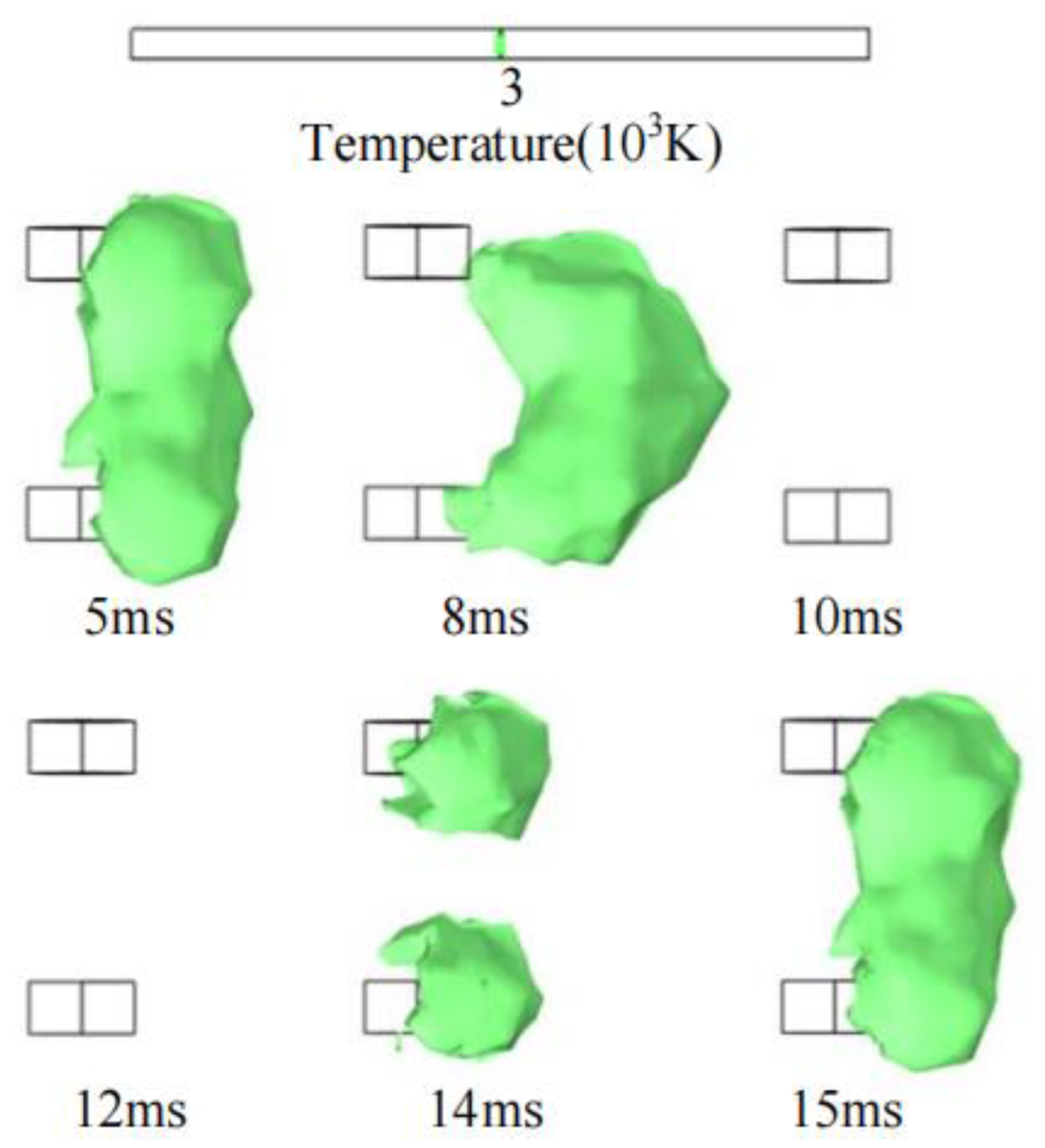
Disclaimer/Publisher’s Note: The statements, opinions and data contained in all publications are solely those of the individual author(s) and contributor(s) and not of MDPI and/or the editor(s). MDPI and/or the editor(s) disclaim responsibility for any injury to people or property resulting from any ideas, methods, instructions or products referred to in the content. |
© 2025 by the authors. Licensee MDPI, Basel, Switzerland. This article is an open access article distributed under the terms and conditions of the Creative Commons Attribution (CC BY) license (https://creativecommons.org/licenses/by/4.0/).
Share and Cite
Li, Y.; Xu, J.; Wang, P.; Li, G. Research on Arc Extinguishing Characteristics of Single-Phase Grounding Fault in Distribution Network. Energies 2025, 18, 256. https://doi.org/10.3390/en18020256
Li Y, Xu J, Wang P, Li G. Research on Arc Extinguishing Characteristics of Single-Phase Grounding Fault in Distribution Network. Energies. 2025; 18(2):256. https://doi.org/10.3390/en18020256
Chicago/Turabian StyleLi, Yan, Jianyuan Xu, Peng Wang, and Guanhua Li. 2025. "Research on Arc Extinguishing Characteristics of Single-Phase Grounding Fault in Distribution Network" Energies 18, no. 2: 256. https://doi.org/10.3390/en18020256
APA StyleLi, Y., Xu, J., Wang, P., & Li, G. (2025). Research on Arc Extinguishing Characteristics of Single-Phase Grounding Fault in Distribution Network. Energies, 18(2), 256. https://doi.org/10.3390/en18020256





